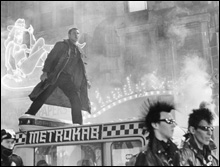Looking for fidelity to the cyber-punk master
By JAMES PARKER | July 5, 2006

BLADE RUNNER: Director Ridley Scott, fresh from Alien, knocked this one out of the park — but was it Dick? |
Philip K. Dick saw into the future, man, the FUTURE. Check it out: the “scramble suit” worn by the narc Bob Arctor in Dick’s 1977 novel A Scanner Darkly — the “shroud-like membrane” across which ceaseless images of human diversity are projected, “every conceivable eye color, hair color, shape and type of nose, formation of teeth, configuration of facial bone structure” — anticipated exactly, and by a full eight years, the shifting personae of Godley & Creme’s celebrated 1985 music video “Cry.” Remember that one? “You don’t know how to ease my pain, you don’t know,” while the smooth, chinless face of a young black girl, mouthing these lyrics, morphs and swells into the porno-bearded countenance of Kevin Godley, and then into someone else? Dick saw it coming.Being a harbinger of music video was not the full extent of his predictive insight, of course. Dick is one of those, like Kafka and the writers of Seinfeld, who have copyrighted certain aspects of reality; certain moments of the day, they own. Time slips, memory holes, loops in the brain, intimations of parallel dimensions — these belong to Dick as reliably as getting fired belongs to George Costanza. The near future, very near, breeding in the cells of the present, was Dick’s thing. True, he trafficked broadly in distant centuries, robots, galactic war, and so on, but these were just the tools of his trade, of the long apprenticeship in pulp sci-fi from which he never, economically speaking, emerged. (He was broke to the end of his days.) His real taste was for a sort of monstrous ontological foreplay, a tickling at the roots of being that had nothing to with spaceships and everything to do with his own rather freaked-out apprehensions. The Philip K. Dick feeling is a version of the aura experienced by epileptics just before they go into seizure — a hum, a warning, like Neil Young’s guitar playing in “Cortez the Killer”: “He came dancing across the water . . . ”
Hollywood, beast that it is, scented the interestingness of Dick without particularly caring to understand it. Of the eight Hollywood movies that have been made from his work, four are drawn from short stories he wrote between 1953 and 1956 — his most underpaid and squanderously prolific period, when he was tossing off half-baked sci-fi ideas with the ferocity of a true hack. And half-baked ideas — the drooling visionaries who see crimes before they are committed (The Minority Report), the businessman who sells chunks of his own memory (Paycheck) — make wonderful High Concepts. Baldly written, in the accelerated, fleshless prose of the deadline artist, these stories read today more like treatments, teasers for a phantom producer. From The Minority Report: “Anderton winced, but outwardly he remained impassive. It cost him an effort, though. He wondered what Witwer really thought. What was actually going on in that closecropped skull?”
 Topics
Topics:
Features
, Entertainment, Movies, Neil Young, More  , Entertainment, Movies, Neil Young, George Costanza, Arnold Schwarzenegger, Vincent D'Onofrio, Peter Weller, Philip K. Dick, Richard Linklater, Sharon Stone, Less
, Entertainment, Movies, Neil Young, George Costanza, Arnold Schwarzenegger, Vincent D'Onofrio, Peter Weller, Philip K. Dick, Richard Linklater, Sharon Stone, Less 